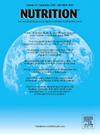Phase angle is associated with nutritional risk in subacute stroke patients at the beginning of rehabilitation
IF 3.2
3区 医学
Q2 NUTRITION & DIETETICS
引用次数: 0
Abstract
Objectives
Malnutrition in stroke is associated with poor clinical outcomes. Bioelectrical impedance analysis–derived phase angle (PhA) is widely used for assessing nutritional status as an index of muscle quality. This study aimed to evaluate the associations between whole body and limb PhAs and nutritional risk in stroke patients. PhA predictors were also identified.
Methods
Consecutive subacute stroke patients aged ≥50 y at the beginning of rehabilitation participated in this retrospective analysis. Nutritional risk was assessed using the Geriatric Nutritional Risk Index, the Prognostic Nutritional Index, and the Controlling Nutritional Status score. PhAs at 50 kHz for both whole body and limbs were measured. The associations between PhA and nutritional risk were examined through univariate/multivariate analyses.
Results
Overall, 272 subacute stroke patients were studied (age, 70.1 ± 12.4 y, body mass index, 26.8 ± 3.9 kg/m²). Both whole body and limb PhAs were associated with Geriatric Nutritional Risk Index, Prognostic Nutritional Index, and Controlling Nutritional Status score, and this was also true in patients aged ≥75 y (P < 0.001). Low PhA values were observed in patients at high nutritional risk. The general linear model identified age, female sex, hypertension, diabetes, dysphagia, and time from stroke onset as independent predictors of PhA (R² = 0.468, P < 0.001). Furthermore, PhA emerged as a significant predictor of high nutritional risk according to each screening tool. Finally, optimal cutoffs of whole body PhA for predicting high nutritional risk were around 4.08°.
Conclusions
In stroke patients, low PhA values were associated with high nutritional risk. PhA at the beginning of rehabilitation may serve as a reliable parameter to be considered in the evaluation of nutritional status.
在亚急性脑卒中患者康复初期,相位角与营养风险相关。
目的:脑卒中患者营养不良与不良临床预后相关。生物电阻抗分析得出的相位角(PhA)作为肌肉质量的指标被广泛用于营养状况的评估。本研究旨在评估卒中患者全身和肢体pha与营养风险之间的关系。PhA预测因子也被确定。方法:对康复开始时年龄≥50岁的连续亚急性脑卒中患者进行回顾性分析。采用老年营养风险指数、预后营养指数和控制营养状态评分来评估营养风险。在50 kHz时测量全身和四肢的相电位。PhA与营养风险之间的关系通过单变量/多变量分析进行了检验。结果:共纳入272例亚急性脑卒中患者(年龄70.1±12.4岁,体重指数26.8±3.9 kg/m²)。全身和四肢PhAs均与老年营养风险指数、预后营养指数和控制营养状态评分相关,在年龄≥75岁的患者中也是如此(P < 0.001)。在高营养风险的患者中观察到低PhA值。一般线性模型确定年龄、女性、高血压、糖尿病、吞咽困难和中风发病时间为PhA的独立预测因子(R²= 0.468,P < 0.001)。此外,根据每种筛选工具,PhA成为高营养风险的重要预测因子。最后,预测高营养风险的全身PhA的最佳临界值约为4.08°。结论:在脑卒中患者中,低PhA值与高营养风险相关。康复开始时的PhA可作为评估营养状况的可靠参数。
本文章由计算机程序翻译,如有差异,请以英文原文为准。
求助全文
约1分钟内获得全文
求助全文
来源期刊

Nutrition
医学-营养学
CiteScore
7.80
自引率
2.30%
发文量
300
审稿时长
60 days
期刊介绍:
Nutrition has an open access mirror journal Nutrition: X, sharing the same aims and scope, editorial team, submission system and rigorous peer review.
Founded by Michael M. Meguid in the early 1980''s, Nutrition presents advances in nutrition research and science, informs its readers on new and advancing technologies and data in clinical nutrition practice, encourages the application of outcomes research and meta-analyses to problems in patient-related nutrition; and seeks to help clarify and set the research, policy and practice agenda for nutrition science to enhance human well-being in the years ahead.
 求助内容:
求助内容: 应助结果提醒方式:
应助结果提醒方式:


